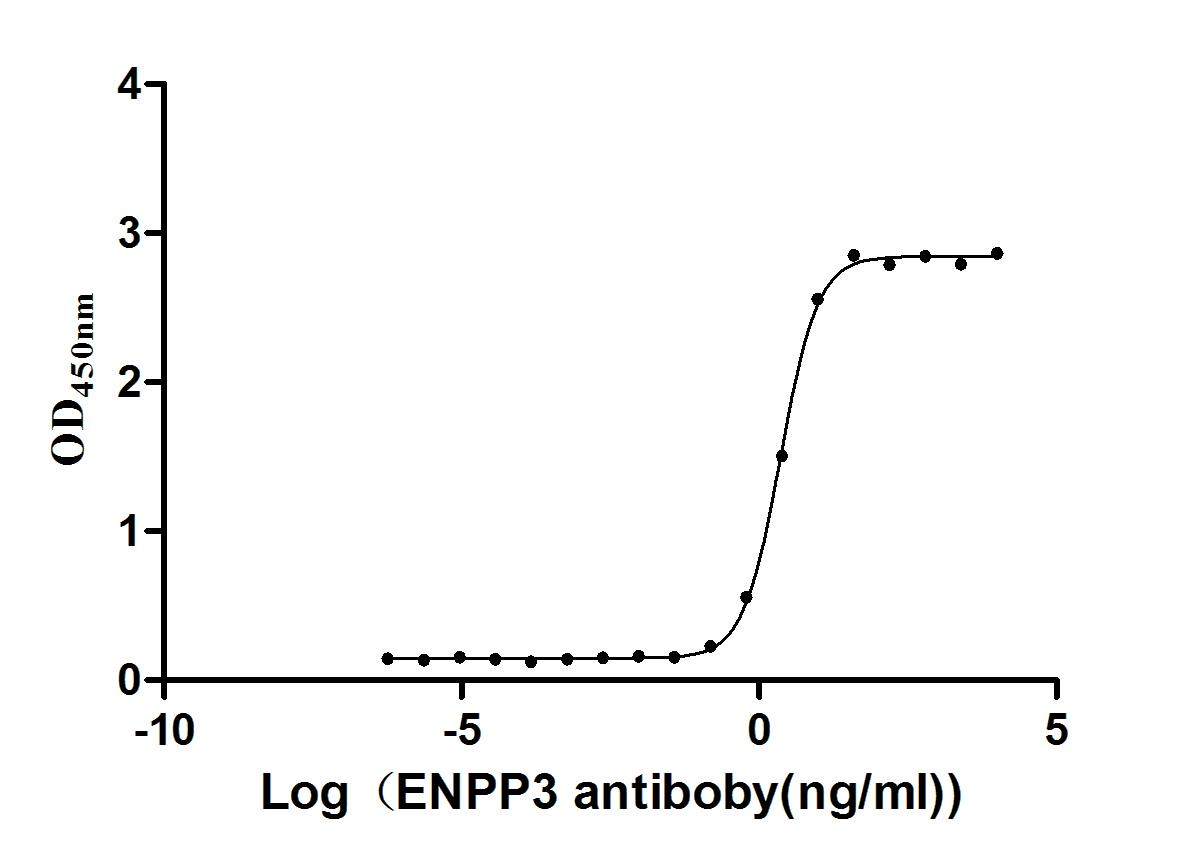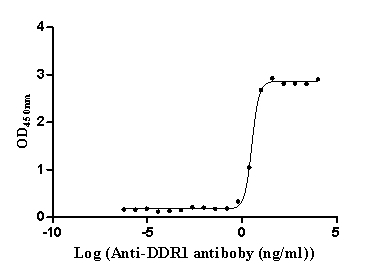Recombinant Arabidopsis thaliana Regulatory protein NPR1 (NPR1), partial
-
中文名稱:擬南芥NPR1重組蛋白
-
貨號:CSB-YP308617DOA
-
規(guī)格:
-
來源:Yeast
-
其他:
-
中文名稱:擬南芥NPR1重組蛋白
-
貨號:CSB-EP308617DOA
-
規(guī)格:
-
來源:E.coli
-
其他:
-
中文名稱:擬南芥NPR1重組蛋白
-
貨號:CSB-EP308617DOA-B
-
規(guī)格:
-
來源:E.coli
-
共軛:Avi-tag Biotinylated
E. coli biotin ligase (BirA) is highly specific in covalently attaching biotin to the 15 amino acid AviTag peptide. This recombinant protein was biotinylated in vivo by AviTag-BirA technology, which method is BriA catalyzes amide linkage between the biotin and the specific lysine of the AviTag.
-
其他:
-
中文名稱:擬南芥NPR1重組蛋白
-
貨號:CSB-BP308617DOA
-
規(guī)格:
-
來源:Baculovirus
-
其他:
-
中文名稱:擬南芥NPR1重組蛋白
-
貨號:CSB-MP308617DOA
-
規(guī)格:
-
來源:Mammalian cell
-
其他:
產(chǎn)品詳情
-
純度:>85% (SDS-PAGE)
-
基因名:
-
Uniprot No.:
-
別名:NPR1; NIM1; SAI1; At1g64280; F15H21.6; Regulatory protein NPR1; BTB/POZ domain-containing protein NPR1; Non-inducible immunity protein 1; Nim1; Nonexpresser of PR genes 1; Salicylic acid insensitive 1; Sai1
-
種屬:Arabidopsis thaliana (Mouse-ear cress)
-
蛋白長度:Partial
-
蛋白標簽:Tag?type?will?be?determined?during?the?manufacturing?process.
The tag type will be determined during production process. If you have specified tag type, please tell us and we will develop the specified tag preferentially. -
產(chǎn)品提供形式:Lyophilized powder
Note: We will preferentially ship the format that we have in stock, however, if you have any special requirement for the format, please remark your requirement when placing the order, we will prepare according to your demand. -
復(fù)溶:We recommend that this vial be briefly centrifuged prior to opening to bring the contents to the bottom. Please reconstitute protein in deionized sterile water to a concentration of 0.1-1.0 mg/mL.We recommend to add 5-50% of glycerol (final concentration) and aliquot for long-term storage at -20℃/-80℃. Our default final concentration of glycerol is 50%. Customers could use it as reference.
-
儲存條件:Store at -20°C/-80°C upon receipt, aliquoting is necessary for mutiple use. Avoid repeated freeze-thaw cycles.
-
保質(zhì)期:The shelf life is related to many factors, storage state, buffer ingredients, storage temperature and the stability of the protein itself.
Generally, the shelf life of liquid form is 6 months at -20°C/-80°C. The shelf life of lyophilized form is 12 months at -20°C/-80°C. -
貨期:Delivery time may differ from different purchasing way or location, please kindly consult your local distributors for specific delivery time.Note: All of our proteins are default shipped with normal blue ice packs, if you request to ship with dry ice, please communicate with us in advance and extra fees will be charged.
-
注意事項:Repeated freezing and thawing is not recommended. Store working aliquots at 4°C for up to one week.
-
Datasheet :Please contact us to get it.
靶點詳情
-
功能:May act as a substrate-specific adapter of an E3 ubiquitin-protein ligase complex (CUL3-RBX1-BTB) which mediates the ubiquitination and subsequent proteasomal degradation of target proteins. Key positive regulator of the SA-dependent signaling pathway that negatively regulates JA-dependent signaling pathway. Mediates the binding of TGA factors to the as-1 motif found in the pathogenesis-related PR-1 gene, leading to the transcriptional regulation of the gene defense. Controls the onset of systemic acquired resistance (SAR). Upon SAR induction, a biphasic change in cellular reduction potential occurs, resulting in reduction of the cytoplasmic oligomeric form to a monomeric form that accumulates in the nucleus and activates gene expression. Phosphorylated form is target of proteasome degradation.
-
基因功能參考文獻:
- This work uncovers a strategy in which Pseudomonas syringae AvrPtoB targets Arabidopsis NPR1 and represses NPR1-dependent salicylic acid signaling, thereby subverting plant innate immunity. PMID: 29174403
- study not only provides a convenient and efficient transient expression system, but also reveals that NPR1-dependent SA signaling is a major barrier to efficient transient expression PMID: 28025761
- We identified a rice mutant in the Kitaake genetic background with a frameshift mutation in crk10; this mutant also displays a compromised immune response highlighting the important role of crk10. We also show that elevated levels of NH1 expression lead to enhanced CRK10 expression and that the rice TGA2.1 protein binds to the CRK10 promoter. PMID: 27176732
- Green tissue-specific expression of Arabidopsis thaliana NPR1 is an effective strategy for controlling the sheath blight pathogen (Rhizoctonia solani) in rice. The present work in rice can be extended to other crop plants severely damaged by the pathogen. PMID: 27457988
- The results revealed a tight correlation between sequential salicylic acid (SA) and sic acid (ABA) signaling and dynamic changes in NPR1 protein levels and NPR1-dependent transcription in plant immune responses. PMID: 26865090
- Crosstalk between nitric oxide and glutathione is integral to the NPR1-dependent defense signaling pathway. PMID: 26096525
- The authors show that sumoylation of NPR1 by SUMO3 activates defense gene expression by switching NPR1's association with the WRKY transcription repressors to TGA transcription activators. PMID: 26269953
- Altogether, our results indicate that AR156 can induce SAR by the SA-signaling pathways in an NPR1-dependent manner and involves multiple PTI components. PMID: 26616055
- NPR1-dependent salicylic acid signaling is not involved in the elevated carbon dioxide-induced heat shock tolerance. PMID: 25874349
- NPR1-dependent salicylic acid (SA) signalling is central to the salt and oxidative stress tolerance in Arabidopsis. PMID: 25614660
- NPR1 was found to be a positive regulator of jasmonic acid-induced expression of MDHAR3 and TAT3. PMID: 22213815
- Fusarium head blight (FHB) severity and mycotoxin accumulation were curtailed in wheat plants treated with SA and in AtNPR1 wheat, which is hyper-responsive to salicylic acid (SA). PMID: 22112217
- Expression of the gene encoding the noexpresser of PR genes 1 (NPR1), a key component of the salicylic acid-signaling pathway, was downregulated by GASA5 overexpression. PMID: 21835493
- The npr1 mutation does not significantly affect oxidative stress-induction of the two genes involved in jasmonic acid synthesis. PMID: 23210597
- Pseudozyma aphidis may inhibit B. cinerea infection via induced resistance in a manner independent of jasmonic acid, salicylic acid, and Nonexpressor of PR1 (NPR1). PMID: 23388119
- The results obtained in this investigation provide further support for a broad-spectrum nature of the resistance conferred by overexpression of AtNPR1 gene in cotton PMID: 23001518
- NPR1 is not necessary for resistance triggered by methyl jasmonate. PMID: 23116333
- NPR1 plays an important role in lipopolysaccharides-triggered plant innate immunity. PMID: 22926319
- NPR1 is the receptor for salicylic acid. PMID: 22813739
- The results suggest that clade I TGA factors are required for resistance against virulent pathogens and avirulent pathogens mediated by at least some R gene specificities, acting substantially through NPR1-independent pathways. PMID: 22876961
- The NONEXPRESSOR OF PATHOGENESIS-RELATED GENES1 (npr1) mutant, defective in cylic acid signaling, is impaired in both the production and the perception of the volatile signals, demonstrating a key role for NPR1 as a central regulator of genome stability. PMID: 22028460
- These results show that the pathogen-triggered or salicylic acid-induced nuclear translocation is prevented by accumulation of hydrogen peroxide in the cytosol. PMID: 21051935
- Data show that the cacao TcNPR1 gene partially complemented the npr1 mutation in transgenic Arabidopsis plants, resulting in 100 fold less bacterial growth in a leaf infection assay. PMID: 21078185
- Mutations if npr1 alleles interact with the paralogs preventing their function in salicylic acid signalling. PMID: 20561252
- NPR1 is S-nitrosylated after treatment with the NO donor S-nitrosoglutathione. PMID: 20716698
- plant proteins bind to NPR1 in vivo and inhibit transcriptional activation of new proteins. PMID: 19825560
- While NPR1 has a positive effect on pathogen resistance, it has a negative effect on symbiotic interactions, by inhibiting root hair deformation and nodulin expression. PMID: 20027302
- Results indicate that the NLS and nuclear localization of NPR1 are required for regulation of SA tolerance, ICS1 expression and SA accumulation. PMID: 19716624
- Cell death phenotypes in the autophagy-defective mutants are dependent on the salicylic acid signal transducer NPR1. PMID: 19773385
- Our results strongly suggest that NIMIN1 negatively regulates distinct functions of NPR1, providing a mechanism to modulate specific features of SAR. PMID: 15749762
- in addition to controlling expression of pathogenesis-related genes, NPR1 controls expression of the protein secretory pathway genes; findings show that NPR1 coordinately regulates these secretion-related genes through a previously undescribed cis-element PMID: 15890886
- NPR1 is required for expression of genes involved in signal transduction after treatment with salicylic acid PMID: 16307367
- Fusarium head blight resistance in the AtNPR1-expressing wheat is a result of these plants being more responsive to an endogenous activator of plant defense. PMID: 16529374
- The effects of thiamine on defense-related responses in A. thaliana infected wtih P. syringae is presented. PMID: 17158583
- These data further the understanding of the mechanism by which TGA2 and NPR1 activate Arabidopsis PR-1. PMID: 17172357
- Heterologous expression of AtNPR1 provides enhanced resistance to early larval populations of the herbivore, Spodoptera in transgenic tobacco plants. PMID: 18397206
- Mutations in NPR1 abolished the enhanced resistance of dnd mutants against Pseudomonas syringae pv. tomato and Hyaloperonospora parasitica but not Botrytis cinerea. PMID: 18785824
- These results suggest that the high induction observed of CalS1 and CalS12 is Npr1 dependent while the weak induction of five CalS genes is Npr1 independent. PMID: 18807070
- Piriformospora indica-induced resistance requires jasmonate signaling and only cytosolic but not nuclear localization of NPR1. PMID: 18842596
- Study highlights a role for NPR1 in basal defence against F. culmorum in some floral organs. PMID: 19018998
- Ethylene modulates the NPR1 dependency of salicylic acid (SA)-jasmonic acid antagonism, possibly to compensate for enhanced allocation of NPR1 to function in SA-dependent activation of pathogenesis-related genes. PMID: 19176718
- This is the first demonstration of the novel function of heterologous expression of AtNPR1 in oxidative stress tolerance in transgenic tobacco. PMID: 19466562
- Study shows that turnover of nuclear NPR1 protein plays an important role in modulating transcription of its target genes. PMID: 19490895
顯示更多
收起更多
-
亞細胞定位:Cytoplasm. Nucleus. Note=Accumulation in nucleus after induction by salicylic acid (SA) treatment or after pathogen infection.
-
數(shù)據(jù)庫鏈接:
Most popular with customers
-
Recombinant Macaca fascicularis Delta-like protein 3 (DLL3), partial (Active)
Express system: Mammalian cell
Species: Macaca fascicularis (Crab-eating macaque) (Cynomolgus monkey)
-
Recombinant Human Signal transducer CD24 (CD24)-Nanoparticle (Active)
Express system: Mammalian cell
Species: Homo sapiens (Human)
-
Recombinant Human Angiopoietin-2 (ANGPT2) (Active)
Express system: Mammalian cell
Species: Homo sapiens (Human)
-
Recombinant Rat Intestinal-type alkaline phosphatase 1 (Alpi) (Active)
Express system: Mammalian cell
Species: Rattus norvegicus (Rat)
-
Express system: Mammalian cell
Species: Homo sapiens (Human)
-
Recombinant Human Epithelial discoidin domain-containing receptor 1 (DDR1), partial (Active)
Express system: Mammalian cell
Species: Homo sapiens (Human)
-
Recombinant Human Microtubule-associated protein tau (MAPT) (Active)
Express system: Mammalian cell
Species: Homo sapiens (Human)
-
Recombinant Human Early activation antigen CD69 (CD69), partial (Active)
Express system: Mammalian cell
Species: Homo sapiens (Human)




-AC1.jpg)



-AC1.jpg)









